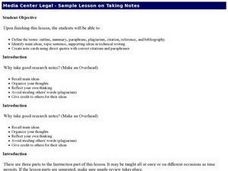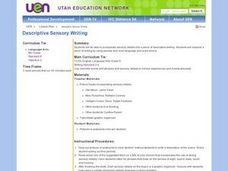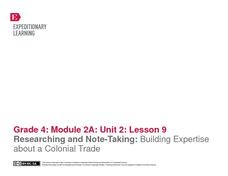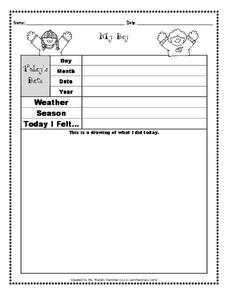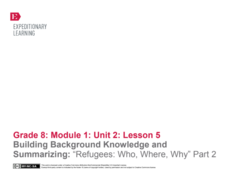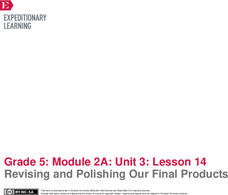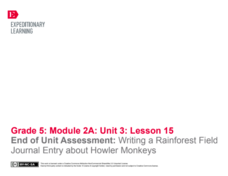Curated OER
Thoreau's Writing Style
Students analyze Thoreau's writing style. In this writing style lesson, students describe Thoreau's literary style and use the devices he employs in a response to one of his essays.
Curated OER
You Too Can Haiku: How to Write a Haiku
Students explore language arts by writing their own poems. In this haiku lesson, students investigate the Japanese culture and their beautiful music, poetry and art. Students count the syllables in every line of a haiku poem and write...
Curated OER
The Writing Process
Students engage in the various steps involved in the writing process. The lesson plan is written as a guide for the teacher to write more in depth lesson plans for specific activities. This is a good model plan to follow.
Curated OER
Please No Posers
How do you reference information correctly? Avoid plagiarism by accurately summarizing a New York Times article with your middle or high schoolers. Young researchers then insert properly attributed quotations and paraphrases into their...
Curated OER
Sample Lesson on Taking Notes
Have your middle schoolers define the terms outline, summary, paraphrase, plagiarism, citation, reference, and bibliography. They identify the main ideas, topic sentence, supporting ideas in technical writing and create note cards using...
Curated OER
Frederick Douglass Expository Reading Guide
Help your high schoolers navigate the cross-curricular text Narrative of the Life of Frederick Douglass with this reading guide. The questions guide learners through composing a summary of any given chapter in the text. In addition,...
Education Center
Safety Sequence
Follow up a class reading of the children's book Officer Buckle and Gloria with this simple sequence-of-events worksheet. Including pictures of six key moments from the story, young learners must first number them in the correct order...
Curated OER
K-W-L Chart
After choosing a topic of interest, young learners use the K-W-L thinking process to create an informational, illustrated, big book. K-W-L, a three-part thinking process, asks the learner to respond to three questions: What do we know...
Curated OER
Using Citations in a Research Paper
As a prequel to a research assignment, class members explore writing citations in the modern Language Association (MLA) and American Psychological Association (APA) formats. In pairs, or individually, researchers use books and magazines...
Curated OER
Descriptive Prompt: Precise Language
Incorporate sensory details into a piece of descriptive writing. First, elementary and middle schoolers improve a piece of writing by using precise, vivid language, as well as appropriate word choice. They then listen to a variety of...
Curated OER
21st Century Book Club
After reading a self-selected book, young reviewers plan, draft, revise, edit and polish a book review as their report on the book. Reviewers record and edit their report which is then placed in the digital library for others to enjoy.
Curated OER
The Island of the Skog
"Students read "The Island of the Skog." Prior to reading, students observe the book cover, predict the events of the story, and discuss what a skog may look like. Students make footprints in play dough and observe the differences...
Curated OER
Summary, Symbolism, and Levels of Meaning - The Healing Totem
Students watch a video and write a summary about a symbolic totem pole. In this symbolism lesson, students discuss the components of summarizing and watch a video about a totem pole. Students write a summary of the video and discuss the...
EngageNY
Researching and Note-Taking: Building Expertise about a Colonial Trade
Building on the previous activity in this unit on colonial trade, the ninth activity has young experts continuing their research and writing summaries of the information they find. To begin, children participate in guided practice where...
Curated OER
Close Reading Passages of Literature
Encourage kids to think deeply about what they are reading with five thought-provoking questions about one passage. After choosing a passage that is intriguing or confusing to them, learners write a summary, explain what they like or...
California Department of Education
Matching Interests and Careers Distance Learning Online Activity
Using the California CareerZone Interest Profiler results, scholars choose an occupation to research then write a summary about what they discovered.
Freeology
Summarizing
Scholars draft a summary using a graphic organizer featuring a story's characters, setting, main events, conflict, and resolution.
Scholastic
Frindle Lesson Plan
"Who says a pen has to be called a pen? Why not call it a frindle?" Inspired by this quote from the award-winning novel written by Andrew Celements, this lesson allows children to invent their own terms for common classroom objects,...
Curated OER
My Day
Youngsters summarize how they felt and what they did on any given day with this adorable template! The document includes space for learners to write the date, weather and season, drawing of the day's major events, and summary of what...
EngageNY
Building Background Knowledge and Summarizing: “Refugees: Who, Where, Why” Part 2
What are some universal aspects of refugees' experiences worldwide and throughout history? Scholars read the text "Refugees: Who, Where, Why" and create two class anchor charts. Finally, they each write a paragraph that provides an...
Channel Islands Film
Santa Cruz Island - Writing for Information
After re-viewing a documentary segment on the restoration of Santa Cruz Island,, individuals craft an essay in which they compare the views of the various stake holders featured in the video and identify the point of view they find the...
EngageNY
Revising and Polishing Our Final Products
One, two, three go! Scholars work independently to finalize the three components of their final task. They complete a science journal entry, scientific text box, and scientific drawing. While working, learners sign up for an appointment...
EngageNY
End of Unit Assessment: Writing a Rainforest Field Journal Entry about Howler Monkeys
Give me more details. Scholars complete an end of unit assessment by creating an information text box to go with their field journal entries about howler monkeys. Learners use the class time to work independently.
Penguin Books
A Teacher's Guide to The Omnivore’s Dilemma: A Natural History of Four Meals by Michael Pollan
"What should we have for dinner?" "What am I eating?" "Where did it come from?" These three questions are at the heart of Michael Pollan's The Omnivore's Dilemma: A Natural History of Four Meals. Pollan's book provides some very...
Other popular searches
- Summary Writing
- Writing a Summary Paragraph
- 4th Grade Writing Summary
- Summary vs. Response Writing
- Summary Writing Powerpoint
- Nonfiction Summary Writing
- Teaching Summary Writing
- Chapter Summary Writing
- Writing a Summary "Esl"
- Summary Writing Activities
- Writing a Summary Esl
- Summary Writing Exemplars






